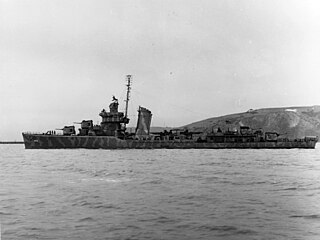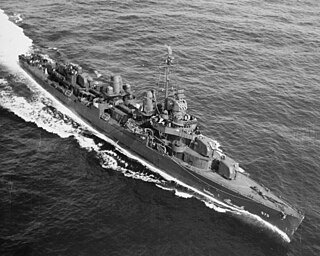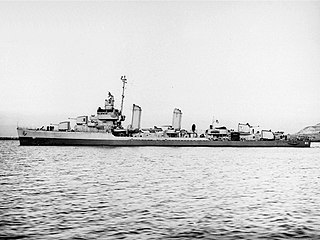
USS Mustin (DD-413) was a Sims-class destroyer of the United States Navy, the first Navy ship of that name, in honor of Captain Henry C. Mustin (1874–1923), a pioneer of naval aviation.

USS Long (DD-209/DMS-12), named for John Davis Long (1838–1915), Secretary of the Navy from 1897 to 1902, was a Clemson-class destroyer of the United States Navy.

USS Morris (DD-417), a World War II-era Sims-class destroyer in the service of the United States Navy, was named after Commodore Charles Morris. She was among the most decorated US Naval vessels of World War II.

USS Hughes (DD-410) was a World War II-era Sims-class destroyer in the service of the United States Navy.

USS Ralph Talbot (DD-390) was a Bagley-class destroyer in the United States Navy, named for USMC Second Lieutenant Ralph Talbot (1897–1918), who was awarded the Medal of Honor during World War I. Talbot served in the Pacific Theater during World War II, from the attack on Pearl Harbor through the battle of Okinawa, earning 14 battle stars for her service.

The first USS Lang (DD-399) was a Benham-class destroyer in the United States Navy during World War II. She was named after John Lang, a sailor in the United States Navy.

USS Stembel (DD-644) was a Fletcher-class destroyer in service with the United States Navy from 1942 to 1947 and from 1951 to 1958. In 1961, she was transferred to Argentina where she served as ARA Rosales (D-22). She was scrapped in 1982.

USS Wedderburn (DD-684), was a Fletcher-class destroyer of the United States Navy.

USS Stafford (DE-411) was a John C. Butler-class destroyer escort in the United States Navy. She was named after Richard Y. Stafford (1916–1942), a United States Marine Corps Captain who died during the Battle of Guadalcanal.

USS Stanly (DD-478) was a Fletcher-class destroyer in service with the United States Navy from 1942 to 1947. She was scrapped in 1972.

USS Schroeder (DD-501), a Fletcher-class destroyer, was a ship of the United States Navy, named for Rear Admiral Seaton Schroeder (1849–1922). Entering service in 1943, the ship saw action during World War II, participating in the Battle of Tarawa. Following the war the destroyer was placed in reserve, remaining in this state until 1972. She was sold for scrap in 1974.

USS Sigsbee (DD-502), a Fletcher-class destroyer, was a ship of the United States Navy named for Rear Admiral Charles D. Sigsbee (1845–1923).

USS Thatcher (DD-514), a Fletcher-class destroyer, was the second ship of the United States Navy to be named for Rear Admiral Henry K. Thatcher (1806–1880).

The first USS Dewey (DD-349) was a Farragut-class destroyer of the United States Navy, launched in 1934 and named for Admiral George Dewey. Dewey served in the Pacific through World War II. After escaping damage during the attack on Pearl Harbor, Dewey screened the aircraft carrier USS Lexington until the carrier was lost in the battle of the Coral Sea; then screened USS Saratoga through the invasion of Guadalcanal and the battle of the Eastern Solomons. Following overhaul in San Francisco, Dewey spent 1943 in Alaskan waters supporting the invasions of Attu and Kiska. Dewey spent 1944 supporting raids in the Marshalls, Carolines, and Marianas, including screening carriers during the battle of the Philippine Sea. After being damaged by Typhoon Cobra during the recapture of the Philippines, Dewey supported the invasion of Iwo Jima and spent the remainder of the war screening replenishment oilers.

USS Lardner (DD-487), a Gleaves-class destroyer, was the second United States Navy ship to be named for Rear Admiral James L. Lardner, a Naval officer during the American Civil War. Lardner received 10 battle stars for World War II service.

USS Smith (DD-378) was a Mahan-class destroyer in the United States Navy before and during World War II. She was named for Lieutenant Joseph B. Smith, USN. Smith was a senior officer aboard USS Congress and killed when CSS Virginia sank her.

USS McKee (DD-575) was a Fletcher-class destroyer, the third ship of the United States Navy to be named for Lieutenant Hugh W. McKee.

USS Coghlan (DD-606) was a Benson-class destroyer in the United States Navy during World War II. She was the second ship named for Joseph Bulloch Coghlan.

USS Frazier (DD-607) was a Benson-class destroyer in the United States Navy during World War II.

USS Kalk (DD-611) was a Benson-class destroyer in the United States Navy during World War II. She was the second ship named for Lieutenant Stanton Frederick Kalk.




















